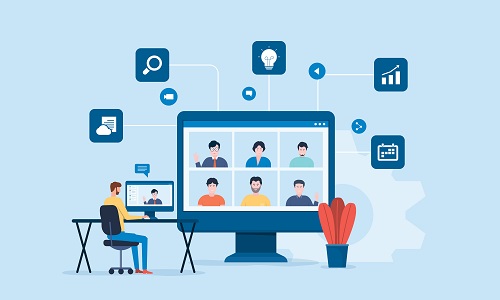For some, hybrid work has become the norm, with 91% of employees with “remote-capable jobs” — positions that could be accomplished fully or partially remote — preferring to work hybrid or remote versus being fully onsite. However, the initial swift change from fully in-person to partially or fully remote work has not arrived without some difficulties. Many of us can relate to challenges with launching virtual meeting tools, and research even shows that 71% of workers experience stress in hybrid meetings. What’s more, 70% are frustrated by recurrent technical issues during meetings.
Now, businesses are looking to improve the systems and solutions available, enhancing efficiency and meaningful digital collaboration for in-office and at-home employees. With hybrid work as the newest workplace standard, businesses that ensure a productive and level working environment will realize the greatest rewards.
So, what is the key to creating a collaborative and fair digital environment that works for all employees? Look toward meeting equity.
What is Meeting Equity?
Meeting equity is about affording everyone — regardless of location — the ability to equally participate in a meeting and contribute to the desired outcome. The consequences of having varying levels of technology can result in a disconnected and disengaged workforce where information is lost in transit. Prior to the pandemic, the concept of meeting equity focused on understanding the diversity of personality types, holding conversation to the meeting objectives, and ensuring meeting flow was not side-tracked or derailed by dominant voices. However, in today’s post-pandemic, hybrid world, the concept has matured.
With the surge of hybrid work, meeting equity has absorbed new, technology-driven elements. And while the variables from meeting equity’s previous understanding remain pertinent, it now pays greater focus to additional factors: such as the ability to see and be seen, hear and be heard, and provide and receive information on an equal basis.
The heads of meetings used to assume a majority of responsibility when it came to meeting equity, encouraging and facilitating factors like a comfortable environment and collaborative behavior. However, now it is also the responsibility of teams at large to sustain this equity by onboarding and enabling current and new technologies to bridge the remote gap. As hybrid work continues to evolve, technology maintains and elevates the ability of all participants — in-person or remote — to equally contribute and learn from meetings. That dynamic is more attainable than ever before.
Technology Enhances Equity
When addressing meeting equity challenges, one solution businesses might consider is to reinforce using asynchronous workflows. The asynchronous model was previously utilized mainly when time zone differences disrupted real-time interactions, but it is now more widely realized as a popular option for efficiency and reaching meeting equity.
An example would be where presenters are able to record themselves with slides, narrate their messages, post the video for others to watch as their schedule permits, and perhaps schedule a Q&A for the next day to engage in discussion. This allows viewing participants to consume and digest the presentation at a time that works best for them, with the least number of distractions, and in a way that fits their personal learning style. In addition, all participants are granted the equal opportunity to pause the video, rewind to re-listen and hold onto the recording for future reference.
To best achieve meeting equity, it is important to determine what specific needs your business and your workforce require to bring it to fruition. How can you advance meeting experiences of remote workers to best resemble those of in-person workers? How can you supply all workers with the ability to equally contribute to the conversation and interchange information?
Also Read: Secure Collaboration in the Hybrid Workplace
This begins with the IT team and identifying what technological upgrades are necessary to create an equal playing field. With these upgrades implemented, it is important to then develop a strategy that produces an environment that encourages collaboration and efficiency — unchanged by the location of workers.
With the future of work standardizing on a hybrid approach, it is crucial to optimize the videoconferencing experience; this is especially true in the business world, where salient decisions, critical deals and employee engagement can be highly swayed by the quality of the experience. For businesses to meet the expectations of today’s hybrid workforce, it will become best practice to shift the outlook on meeting equity from a “nice-to-have” to a “necessity.”
Meeting technology must seek to minimize the occurrence of discussion disruptors that impede the natural flow of conversation which prevent efficiently getting to the objectives of the gathering.
Audio issues lead to “Can you repeat that?” or “Who said that?”. Even worse is when the person who didn’t hear clearly is afraid to speak up during the meeting to clarify. There are also visual issues where the person talking is either not on camera or they are too small to be recognized, or their body language while speaking is uninterpretable. These are critical elements to full human communication, and, in the virtual-meeting space, they continue to raise challenges.
 Martin Bodley is director, emerging business, with Bose Corp.
Martin Bodley is director, emerging business, with Bose Corp.






































